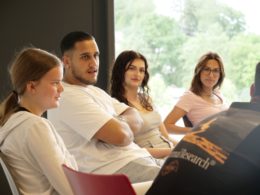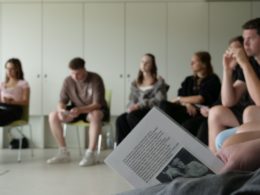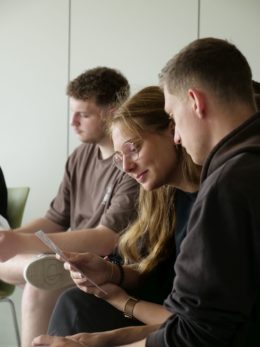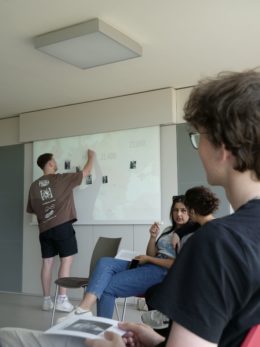Cooperation project with Audi
Seminar weeks with trainees from Ingolstadt and Neckarsulm
In seven subcamps of the Flossenbürg concentration camp, Auto Union AG, the predecessor of AUDI AG, exploited thousands of male and female prisoners from all over Europe for arms production.
Against the backdrop of this history, Audi and the Flossenbürg Concentration Camp Memorial have been working together since 2016 and have launched joint seminars. These enable young Audi employees to engage with history at an early stage in their careers.
Three times a year, seminars are conducted for 20 apprentices each from the Ingolstadt and Neckarsulm sites. These apprentices typically train as office management clerks, automotive mechatronics technicians, or warehouse logistics specialists. For four days, the voluntarily participating trainees in Flossenbürg immerse themselves in the subject matter under the guidance of the memorial's educational team. The lives and imprisonment of prisoners are central topics, as are questions about perpetration and the scope for action within the “consent dictatorship” of National Socialism, both in terms of companies involved in crimes and German society as a whole. The seminar also includes a trip to Zwickau, the company's founding location and the site of a former sub camp. The August Horch Museum Zwickau serves as our local point of contact and close partner for the educational program.
Audi finances the full-time position of a research assistant in the education department for the conception and implementation of these seminars. Audi also provides financial support for the educational work of the memorial.
Multi-perspectivity is key
Trainees learn about the seminar through announcements at their locations and are granted leave from work for the four days by their training supervisors. They are always supervised and accompanied by individual trainers and members of the youth training representatives (JAV). The trainees bring diverse historical perspectives: many participants have family biographies outside Germany, varied places of origin, different school qualifications, and unique associations with the topic of National Socialism. This multi-perspectivity is embraced in the seminar, and participants are encouraged to incorporate their diverse backgrounds into the educational process.
Participants initially explore historical contexts through pictures and event maps along a timeline, identifying key points relevant to their own biographies. A first tour of the former concentration camp site, heavily marked by post-war society's treatment through the construction of detached houses and its subsequent use as an industrial site, opens up space for questions and discussions that will remain a topic for the following days: Does everything really begin in 1933 and end in 1945? What were the antecedents and after-effects of National Socialism—and for whom?
Who were the people in Flossenbürg concentration camp -- on both sides of the camp fence?
On the second day of the seminar, participants delve into the lives of individuals from diverse backgrounds—varying in origin, age, gender, and sexuality—united by their connection to Flossenbürg. Working in teams, they explore the biographies of prisoners who were persecuted as Jews, Sinti and Roma, Soviet prisoners of war, as "asocial" or homosexual, and were imprisoned in Flossenbürg concentration camp and/or its sub camps. The day focuses on contrasting the self-image of these individuals with the racial ideological attributions imposed on them by the National Socialists.
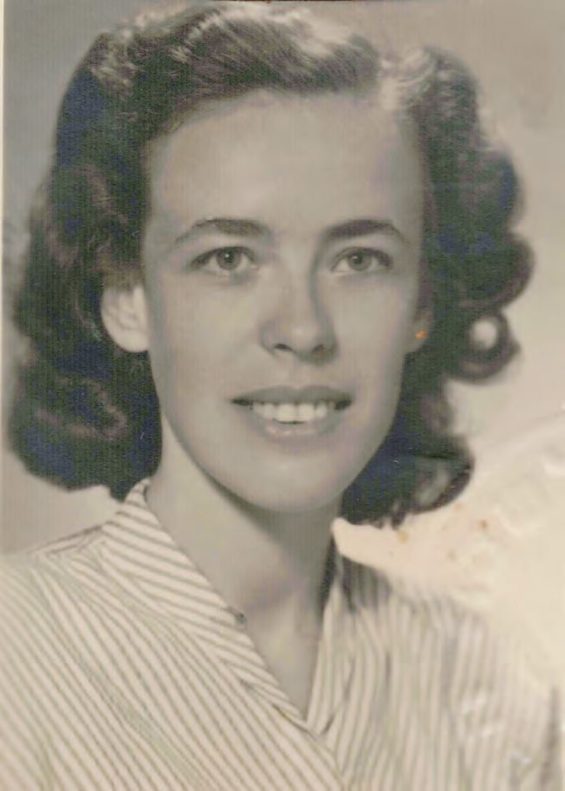
Hana Malka, 1947. Photo: Private collection
Repeatedly, Audi and Auto Union come into focus—for example, in the case of Hana Malka, born in Czechoslovakia, who was forced to perform labor for a supplier company in the Oederan subcamp. Another example is Leo Steinweg, a German Jew who was celebrated as a racing driver for the Auto Union company DKW before 1933 but was later imprisoned by the National Socialists and murdered in February 1945 in the Obertraubling subcamp near Regensburg.
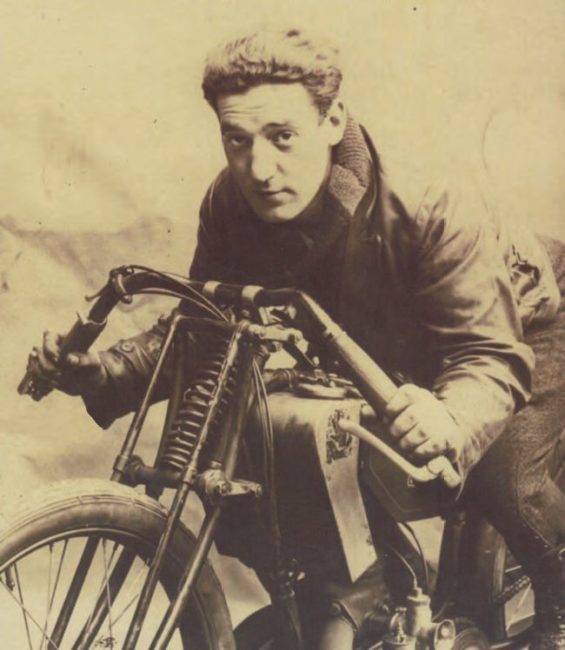
Leo Steinweg, 1930s. © Aschendorff Verlag, Münster
The biographies also include those who share the intersection of “Flossenbürg” with the others but were on the other side of the camp fence. A comparative look at perpetrator biographies after 1945 reveals that while the surviving former prisoners continued to struggle with existential challenges and, in some cases, renewed persecution, life for their tormentors was largely carefree; they were usually able to continue their careers seamlessly and faced little to no consequences. This enables an early discussion about the various dimensions of perpetration and the inadequate way it has been dealt with in West and East Germany to this day—an aspect that will be addressed later in the seminar when the focus turns to Auto Union and Audi and the responsibility of the company management at the time.
In the afternoon, the trainees are given various options to explore these insights and topics in greater depth using the exhibitions, objects, documents and film clips. Independent or group work alternates with moderation and guidance from the seminar leaders, and work with the specific historical site with research into the wider context. There are also plenty of breaks, playful elements and opportunities for personal exchange.
Auto Union AG under National Socialism
During the day trip to Zwickau, the seminar leaders and trainees now relate all of these learning processes to the specific context of Audi/Auto Union and its use of concentration camp prisoners as forced laborers. Zwickau and the August Horch Museum there provide the necessary infrastructure and the background foil in the exhibition area: vintage cars from the Auto Union companies Horch, DKW, Wanderer and Audi (the four rings in the company logo, which AUDI AG adopted as the successor to Auto Union), which are replaced in one of the rooms by tracked vehicles, bucket trucks and machine guns. Between 1933 and 1945, the company switched to armaments production, and with the start of the war in 1939, so-called “civilian” forced laborers were also deployed in the factories - partly recruited, partly conscripted men and women from occupied countries. However, as the war became increasingly hopeless for the Germans from 1942 onwards and the National Socialists' delusional pursuit of “final victory”, the demand for labor could no longer be met even with these workers. Concentration camp prisoners were now also deployed as forced laborers in German companies, including at Auto Union from mid-1944. The company's production sites in what is now Saxony and the Czech Republic became sub camps of the Flossenbürg concentration camp.
In the Zwickau subcamp, Auto Union and the SS exploited a total of 1,000 concentration camp prisoners for the construction of Wehrmacht vehicles, airplanes and torpedoes. They were at the lowest level of forced laborers in terms of food, occupational safety and hygiene standards. The sub camp was located in a separate area of the factory premises, and work took place in two shifts in the so-called “Horch building”. Disease, cold, malnutrition and violence at the hands of the SS and Kapos claimed countless lives. Nothing remains of the sub camp today. The building still stands, a few hundred meters away from the museum. However, it is now an industrial ruin that is no longer accessible.
Where does the responsibility lie? Scope for action and references to the present
But how exactly did it come about that a company like Auto Union used concentration camp prisoners? What room for maneuver did the company have? In the seminar, the trainees approach this question using documents such as minutes, letters and other internal company and official correspondence. This makes it clear that Auto Union proactively requested prisoners from the SS. There was no compulsion on the part of the Nazi state to do so. It would have been possible to act humanely and disassociate the company from the Nazi crimes.
Why did the company management nevertheless decide to use the prisoners, as did (almost) all well-known German companies? How do we assess this? How was it dealt with after the war and what lessons can we learn from it today? The seminar leaders use interactive methods to provide space for discussion of these questions.Finally, it is important to note that, much like the perpetrators within the concentration camps themselves, those responsible at Auto Union experienced largely uninterrupted careers and continued prosperity after the war. Following the relocation of its headquarters from Saxony to Ingolstadt, the company resumed operations as AUDI AG, shifting to civilian production and quickly achieving record sales. In stark contrast, the surviving prisoners and forced laborers were left to fight for recognition and compensation for the rest of their lives.
The discussion then moves beyond this specific context to address broader questions: What role do human rights and moral responsibility play today in comparison to economic logic and authority? And what role should they play? Trainees are consistently encouraged to relate these questions both to their roles within the company and to their own personal life experiences.
"You need to know about it"
The final day of the seminar is dedicated to consolidating the thoughts and insights gained and reflecting on them before everyone returns to Ingolstadt and Neckarsulm, following a shared farewell lunch. Before departing, however, participants are given one last assignment: What do you want to take away from this seminar, and how will you share it—both within and beyond the company? The group then spreads out across the site and exhibitions, creating video clips and Instagram posts, or even beginning to develop mobile learning modules for the company’s internal training system, ensuring their experiences can reach colleagues across the organization.
“I didn't know that Audi had forced laborers,” says Louis Thullner, a first-year apprentice in bodywork and vehicle construction mechanics at the Neckarsulm site. After taking part in the seminar, he can now act as an ambassador for this topic in his working environment. “Not everything is so rosy in the company's history, and you need to know about it so that it doesn't happen again.”
